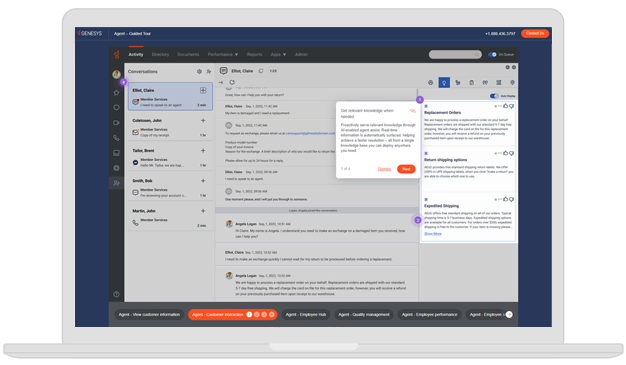
Artificial intelligence (AI) is no longer a distant promise for contact centers — it’s here, reshaping how customer service teams operate, scale and deliver value. From virtual agents handling common requests to real-time predictive engagement, the capabilities of contact center AI are rapidly evolving. And yet, despite growing adoption across industries, persistent myths and AI misconceptions still cloud the conversation.
Some leaders fear AI will make human agents obsolete. Others assume it can’t handle complex customer interactions or deliver the empathy required for high-stakes service. These misunderstandings not only stall innovation and contact center transformation, but they can also result in missed opportunities to improve agent performance, reduce costs and enhance customer satisfaction.
As contact center AI technologies progress from experimental pilot programs to mission-critical infrastructure, it’s essential to separate hype from reality.
Understanding the rise of AI in contact centers
The evolution of contact center technology
Customer service has always evolved alongside technology. From switchboards and call queues to IVR systems and omnichannel platforms, each leap has aimed to reduce friction and improve responsiveness.
But traditional tools often struggled to keep pace with rising call volumes, fragmented customer data and growing expectations. What AI is now capable of marks a turning point — not just a new feature set, but a fundamentally different approach.
Instead of reacting to requests, today’s AI-powered systems can anticipate them. Advanced machine learning, natural language processing and real-time analytics now allow contact centers to act with speed, precision and context, at scale. This shift enables more dynamic, personalized support while freeing agents from repetitive tasks. And the power of AI is only growing.
Current trends in AI adoption across US contact centers
As a result, across the US AI adoption is accelerating. According to our recent industry research, CX leaders surveyed expect to allocate 33% of their CX-related budget to AI-powered technologies in the next 12 months. Growth will likely be especially strong in sectors like retail, financial services and healthcare, where speed and personalization are key.
According to “The Inner Circle Guide to Agentic AI” from ContactBabel, and sponsored by Genesys, companies are adopting AI to increase the sophistication, accuracy and effectiveness of self-service. They’re also using it as a way to improve the understanding of its customers.
Many leaders are moving beyond experimental pilots and leveraging AI into core workflows. As a result, the number of conversations handled by intelligent virtual agents is rising, while AI-supported agents are improving resolution rates and reducing handling times. What was once optional is becoming foundational.
The most common myths about AI in the contact center
Myth #1: AI will replace all human agents
One of the most persistent myths is that AI will eventually render human agents obsolete. It’s an understandable fear, but a misleading one.
In reality, successful contact centers aren’t replacing people — they’re empowering them. AI is increasingly being used to handle a wide range of high-volume customer inquiries, guide users through self-service flows, summarize previous interactions, and even assist live agents in real time with next-best actions or compliance support.
These aren’t always the moments that define customer loyalty, but they can be the ones that prepare human agents to succeed when it matters most. And while AI capabilities continue to grow, they’re still designed to augment the human agent’s role, not eliminate it.
Myth #2: AI lacks the ability to deliver personalization
Another common misconception is that AI can’t personalize customer interactions. The truth is, AI can actually enhance personalization — when implemented thoughtfully. By analyzing real-time and historical data, AI can detect intent, predict needs and surface the most relevant responses or next-best actions.
It can also adapt tone within brand guidelines. Personalization doesn’t mean replacing the human touch — it means augmenting it with speed and precision. When AI and human agents work together, experiences can become not only more efficient, but more tailored to each individual customer.
Debunking the top AI myths
Why human agents remain essential in the age of AI
Even as AI adoption accelerates, the role of human agents has never been more critical. Today’s contact centers are dealing with a wider range of customer expectations and more emotionally charged interactions. While AI can handle repetitive tasks and straightforward inquiries, it’s the human agent who brings greater nuance and emotional intelligence to the table.
AI is a tool — not a replacement for human presence. It doesn’t intuit customer frustration, improvise when things go off-script, or build rapport during a tough conversation. Customers still seek connection, especially when problems are complex or stakes are high. In those moments, the value of the human touch is undeniable.
Forward-looking leaders are embracing a hybrid model. Virtual assistants and AI copilots handle the groundwork, allowing agents to focus on higher-order challenges. This can not only improve agent performance but also elevate the customer experience. Human agents aren’t being replaced by AI. They’re being freed by it.
How AI enhances personalization and empathy
Contrary to the myth that AI is cold or impersonal, it’s increasingly capable of enhancing the emotional quality of customer interactions. The key lies in how it’s used. AI models can detect tone, sentiment and intent in real time — and prompt agents with context-sensitive recommendations. It can adjust its own language to align with a customer’s mood. It can surface relevant past interactions that help agents understand who they’re speaking with, and what matters most in the moment.
This is where personalization and empathy converge. AI doesn’t replace human warmth; it helps ensure that every interaction starts on the right foot. When a virtual assistant greets a returning customer by name and remembers their last issue, that signals care. When a live agent is supported by real-time guidance tailored to the customer’s needs, that strengthens connection. The result isn’t less human, personal or warm — it’s more so.
The reality of AI capabilities in the modern contact center
Across industries, AI is already driving measurable improvements in how contact centers serve customers. Conversational AI solutions now can resolve high volumes of routine inquiries through natural language processing — enabling faster responses without increasing call volumes.
Virtual assistants handle tasks like password resets, order tracking or appointment scheduling, reducing wait times and alleviating time-consuming tasks so human agents can focus on more complex needs. Ultimately, this can help to improve agent productivity.
AI is also streamlining the experience behind the scenes. Predictive analytics help route customers to the best available agent, based on issue type, customer sentiment or past interactions. Intelligent IVR systems guide callers with context-aware prompts, minimizing transfers and repetition. These aren’t future-state experiments — they’re active deployments that transform contact center operations today.
AI’s role in performance monitoring and quality assurance
Beyond customer-facing interactions, AI is transforming how leaders monitor, coach and improve agent performance. Traditional quality assurance processes often relied on manual reviews of small interaction samples, guided by subjective criteria and reacting only after issues surfaced. Now, machine learning and neural networks enable automated, post-interaction analysis of every conversation, delivering timely, objective insights that empower proactive, continuous improvement.
AI tools automatically flag critical moments, identify coaching opportunities and score interactions for compliance, tone and resolution. This creates a consistent, data-driven approach to performance management while giving supervisors more time for meaningful feedback. It also helps agents improve faster, with targeted insights tailored to their needs. The result: stronger customer experiences and a more empowered contact center team driven by visibility, not guesswork.
Practical benefits of AI for contact center leaders
Increased efficiency and cost savings
AI also enables contact centers to operate with greater efficiency by automating repetitive tasks, reducing manual work and optimizing call center operations. Virtual agents and predictive routing help decrease average handle times and reduce the number of customer conversations requiring live agent support. This can drive down operational costs while improving service consistency. AI-powered forecasting tools also help align staffing to actual demand, minimizing over- or under-resourcing, which is especially valuable in high-volume environments. This can result in lower costs and a wiser use of resources.
Empowering agents with intelligent tools
The fact is, rather than replacing agents, AI is equipping them with the smart assistance they need to excel. Agent copilot tools surface relevant knowledge articles during live interactions, reducing lookup time and cognitive load. Natural-language-understanding (NLU) sentiment detection can help agents adjust their tone or approach.
And post-call summaries powered by natural language processing (NLP) free agents from tedious post-interaction work, enabling improvements in focus and job satisfaction. These capabilities enhance both agent performance and the overall customer experience. When agents feel supported and informed, they are empowered to bring more empathy, accuracy and confidence to every interaction, preserving the human touch while benefiting from the power of AI.
AI and humans in the balance
The future of customer service isn’t AI or humans — it’s both, working in harmony. As the popular myths fade and real-world results continue to emerge, it’s becoming undeniable that AI is not a threat but a force multiplier for contact center teams.
Leaders who strategically embrace technologies like generative AI and agentic AI, with a clear understanding of the advanced capabilities available for today’s contact center teams, stand to unlock new levels of efficiency, personalization and satisfaction. It’s time to move past the hype and reimagine what great service looks like in the age of intelligent automation.






